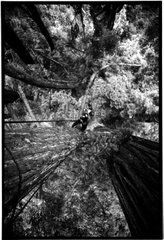
Tuesday, March 27, 2007
Subscribe to:
Comments (Atom)
Nestled in Nanning Creek in an ancient old growth redwood grove, two massive trees—dubbed Spooner and Grandma—enchant their protectors with resident flying squirrels, neighborly salamanders, and treetop fern and mushroom gardens. Spooner—more than 42 feet around and 290 feet tall—and Grandma—attached to her Siamese twin, Grandpa—rest on the edge of a cliff directly above the Nanning Creek watershed and are likely the largest trees ever defended by sitters here.



